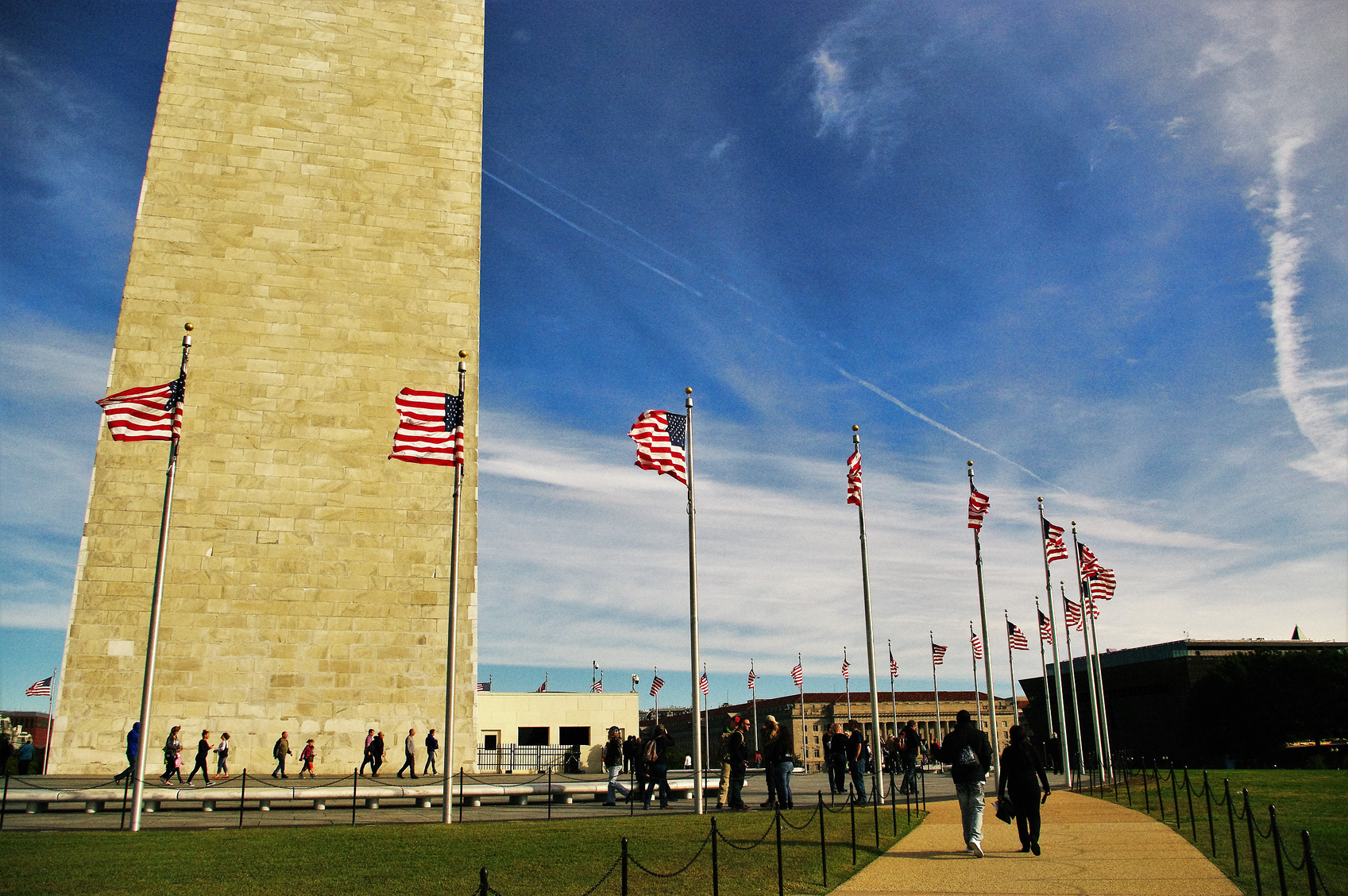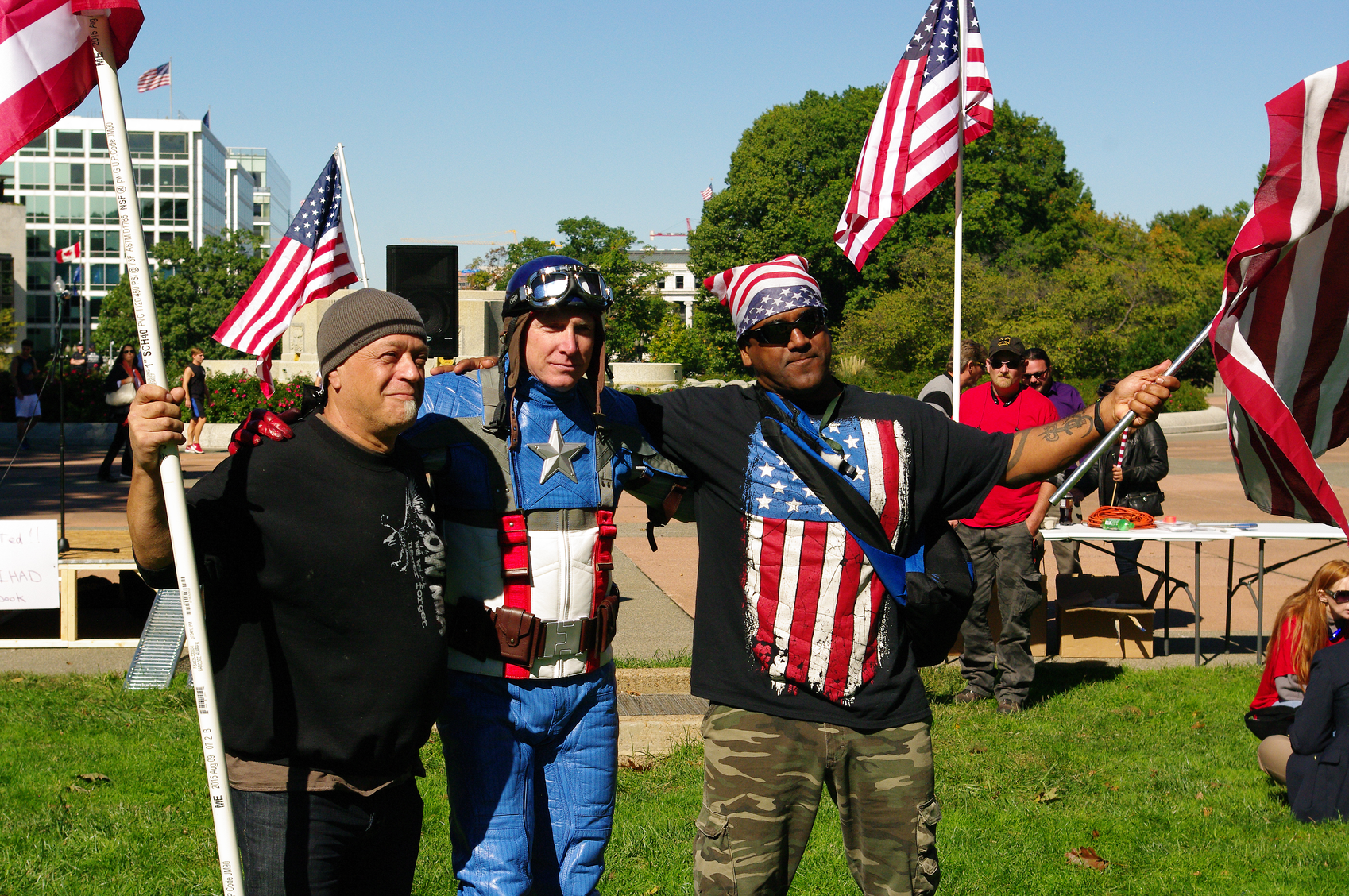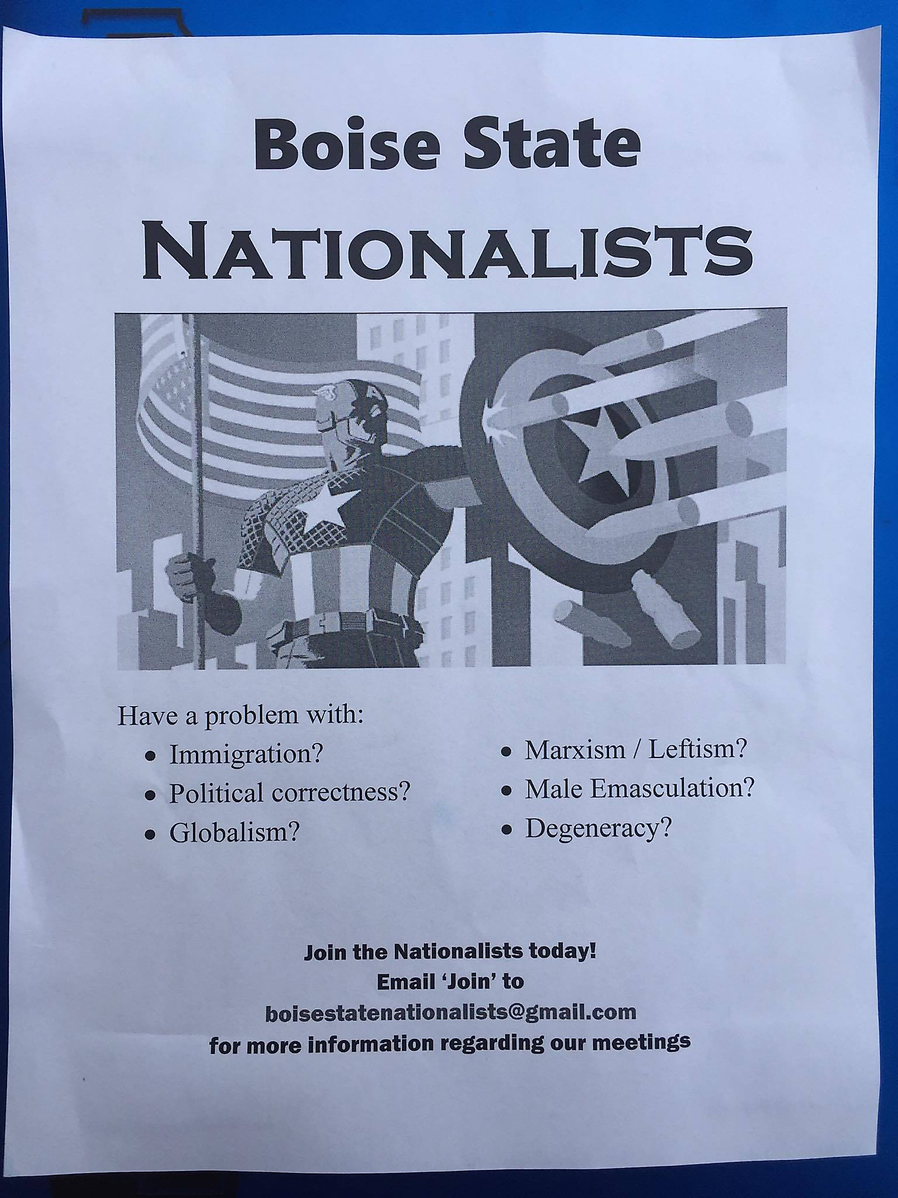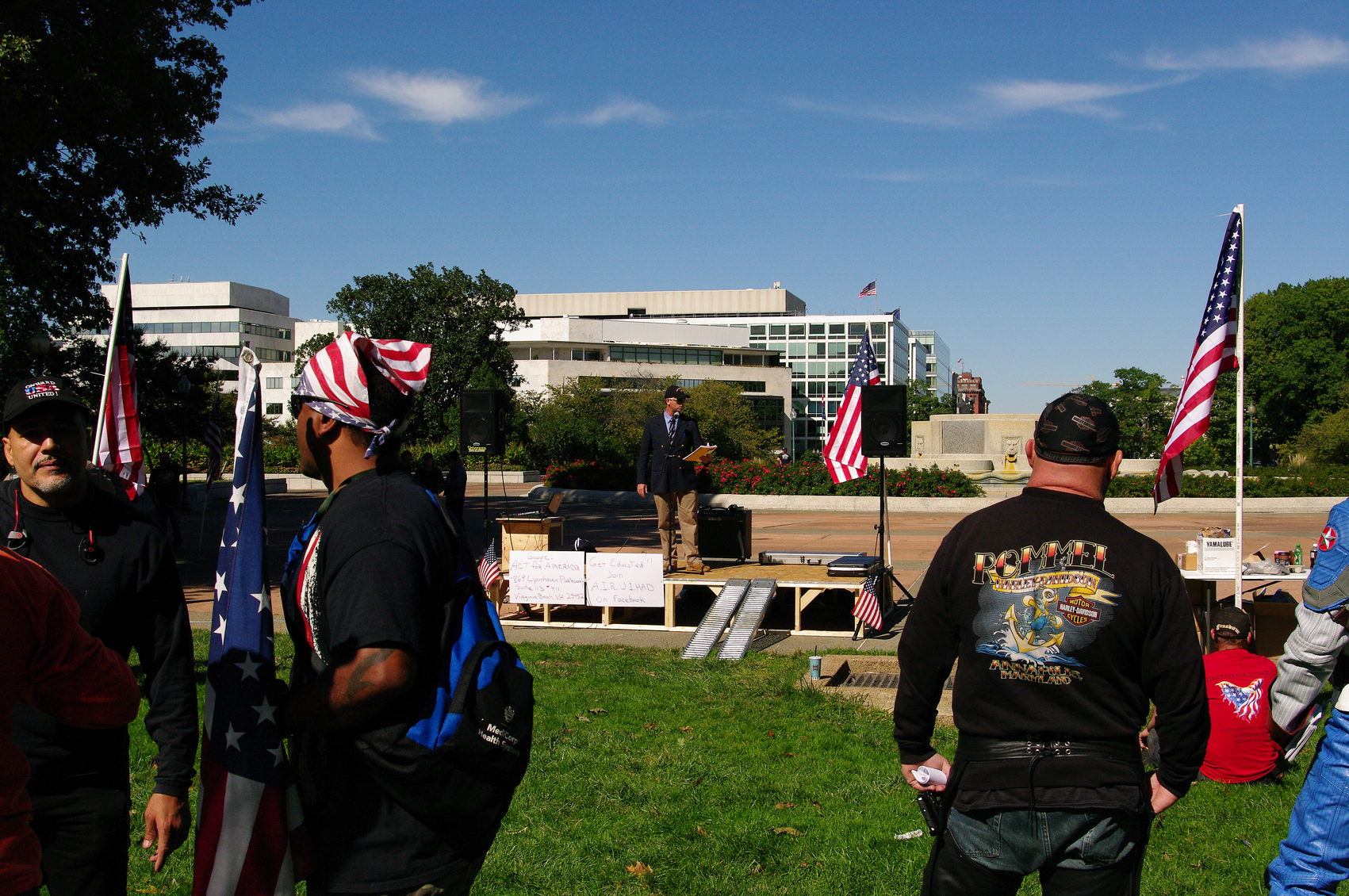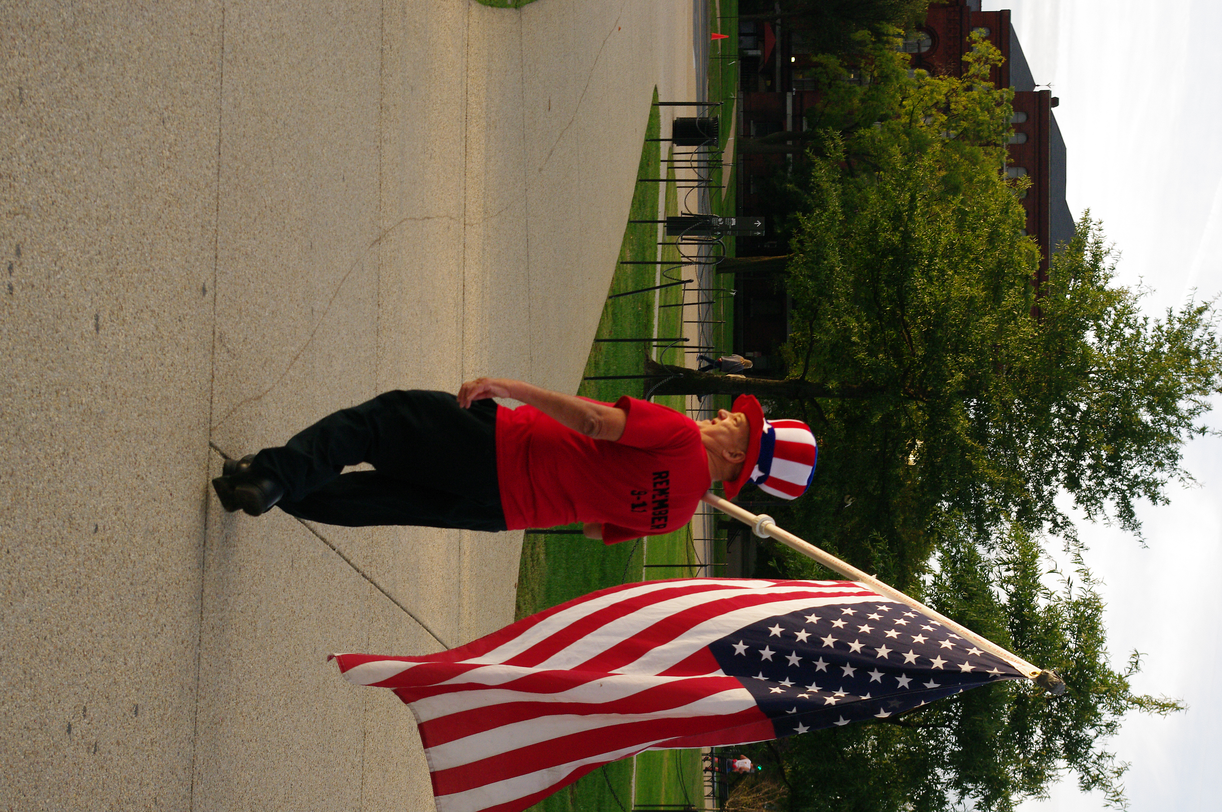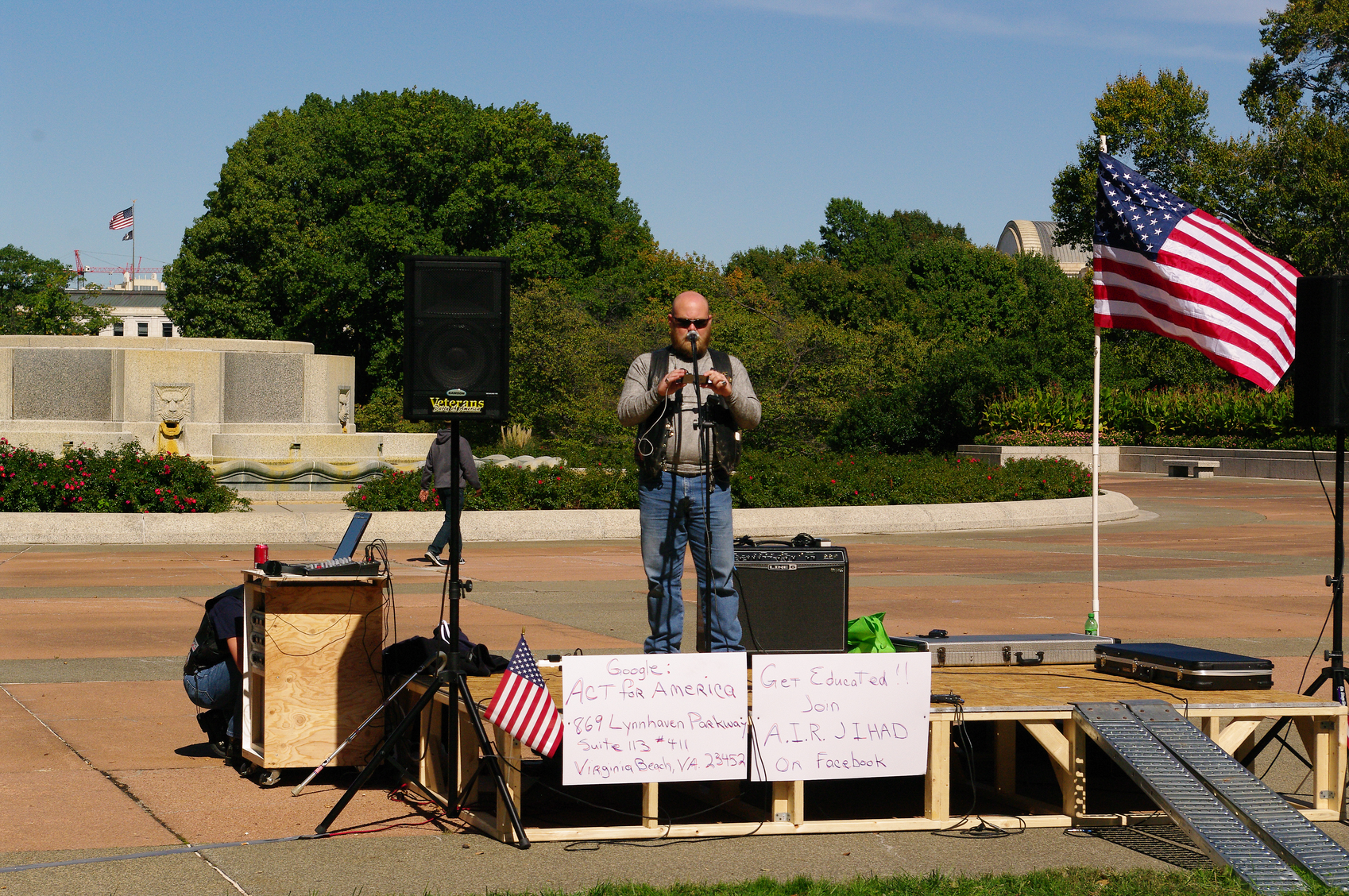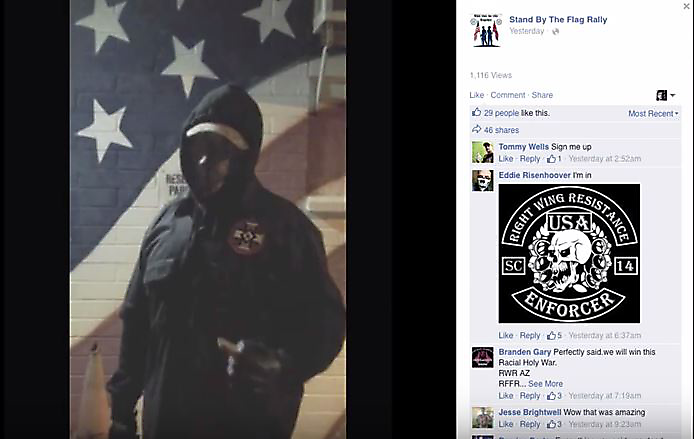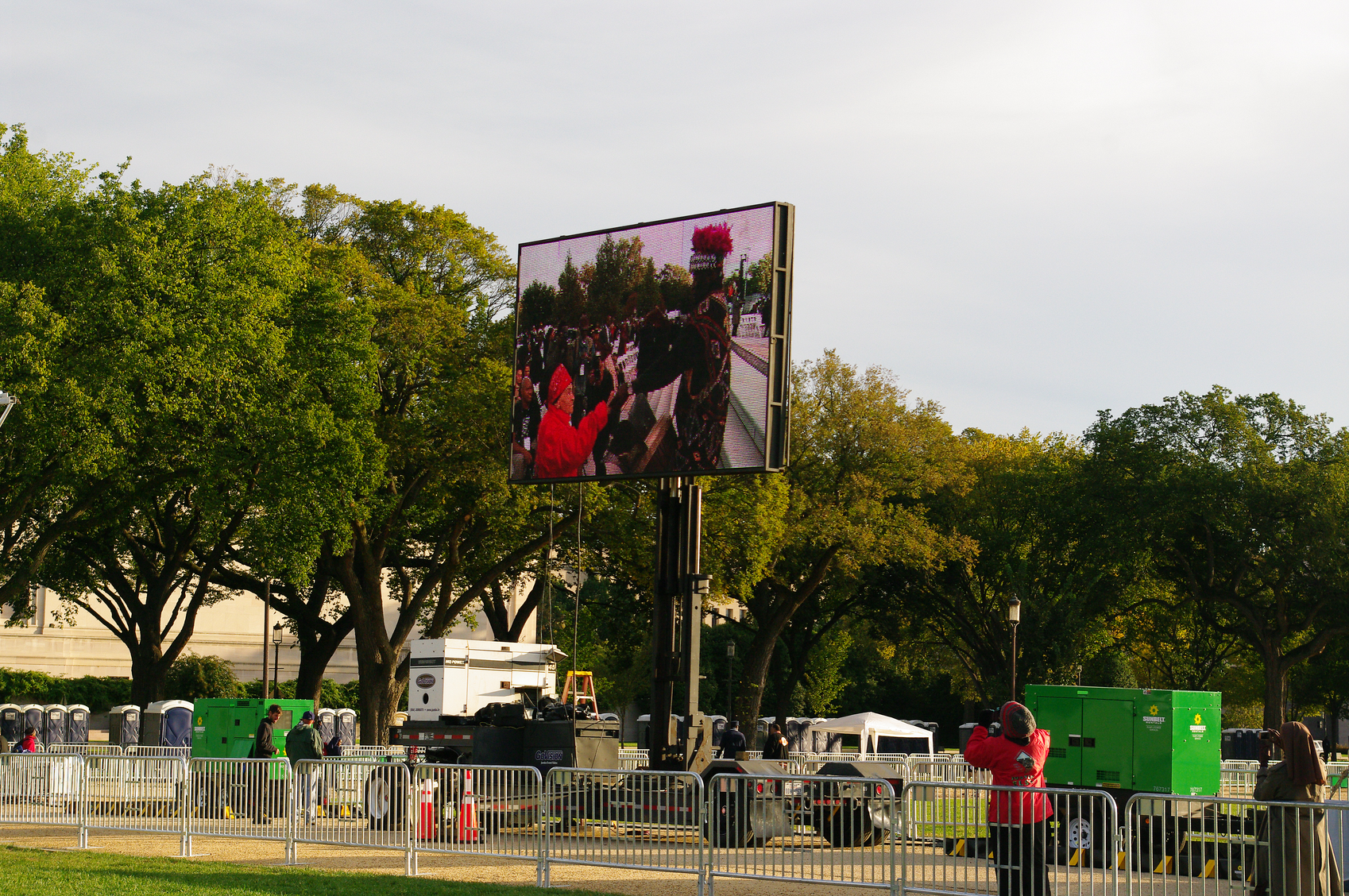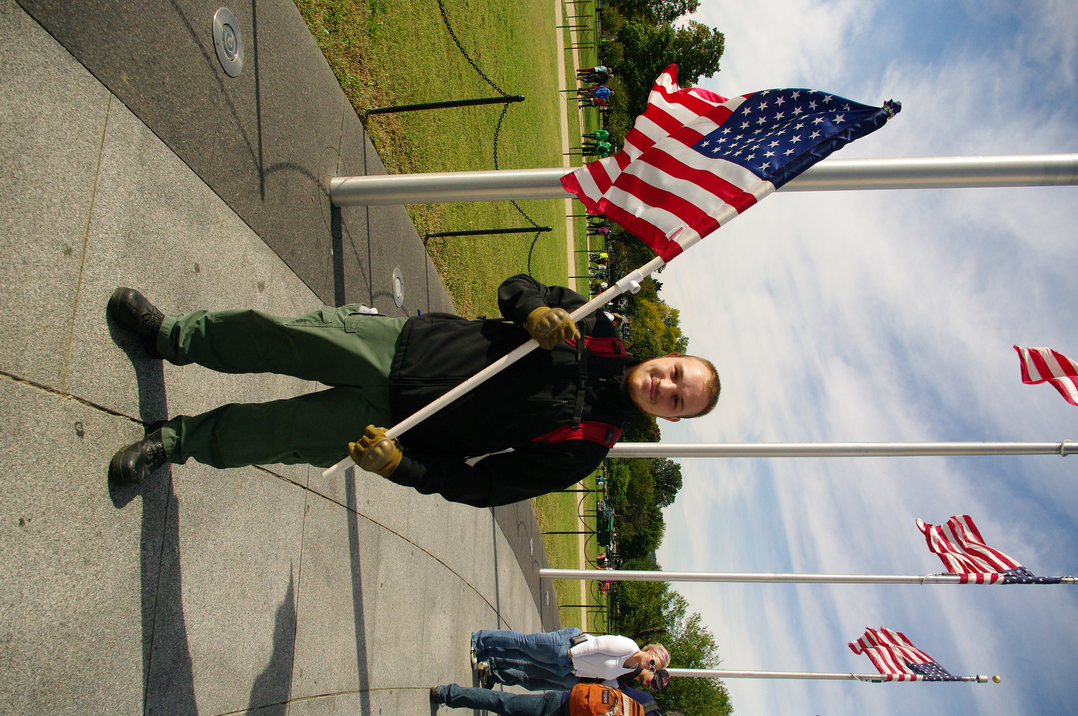Soundscape of the Justice or Else rally constructed from a white nationalist standpoint acoustemology
Louis Farrakhan’s and the Nation of Islam’s Justice or Else rally against Black oppression was presented by US popular media outlets in two ways. I broadly paraphrase their disparate tones and voices here:
- In the aftermath of high profile police violence against African American and Black women and men across the United States, the Nation of Islam organized a multi-faith rally on the U.S. National Mall to promote anti-racist solidarity among an international community of peoples oppressed by various forms of racism.
- In the midst of Islam’s continued assault on American Christianity, and a proxy war on free speech rights as part of the secret institution of Sharia Law under Barrack Hussein Obama, the Nation of Islam organized all of the niggers in America to attempt to conquer the U.S. Capitol under the guise of “interfaith” protests.[1]
Justice or Else intended to capitalize on the symbolic significance of October 2015 in the United States, the 20th anniversary of the Million Man March that intended to “convey to the world a vastly different picture of the Black male” (Million Man March National Organizing Committee 1996). But, to the white nationalist communities with whom I am currently doing ethnographic research, this marked the anniversary when “niggers gathered to demand more government handouts,” as one informant put it. To white nationalists, the first description of Justice or Else was “liberal backwash.” The second version, promoted by fringe political news outlets, was labeled “Truth.” As the Washington Examiner asked: “Even the event name change [From Million Man March to] Justice or Else suggests not a call for self-improvement, self-determination, or self-reflection, but a call for militancy. Why doesn’t the media ask ‘Justice or Else what?’” In response to this Truth of black-on-white mass violence, a private militia and other white nationalists organized to defend their America from Justice or Else.
The Virginia III% Security Force, a private, white militia, used the Washington Monument as their initial meet-up point for surveillance of the Justice or Else Rally. Members told me that, because of Washington DC’s strict gun laws regarding the National Mall, “the guns were across the river” in Virginia.
Rahm and Ken stand with Captain America, who is often an implicit mascot for white nationalists. In the clip, Rahm speaks of the dangers of Muslims. According to other white nationalists at the rally, Rahm’s Israeli nationality makes him immune to criticisms of Islamaphobia, because “he’s middle eastern too.”
The soundscape presented here attempts to capture the sonic experience of civil rights rallies from the position of anti-Black, white nationalists. They gathered to protest Justice or Else, specifically, as part of a “Global rally for Humanity” counterprotest that was supposed to occur across the United States. “Don’t be sitting at home on 10/10 while they are all talking about killing white folks. Exercise all your constitutional rights [by bringing your gun],” John E. Rebel told Global Rally for Humanity goers on his YouTube channel. For American white nationalists, civil rights is typically presented as a form of “reverse racism,” forms of “diversity thought” that legitimate violence against white people for histories of slavery that are neither their fault, nor their responsibility (according to white nationalists themselves).
Beneath these sonic experiences is what I call a standpoint acoustemology. Standpoint Acoustemology, broadly speaking, combines a classic sound studies concept with Black and Marxist (and Black Marxist) Feminist theorizations of knowledge. Steven Feld’s (1990; 2012) concept of acoustemology, developed through ethnographic work with Kaluli people of Bosavi, refers to “local conditions of acoustic sensation, knowledge, and imagination embodied in the culturally particular sense of place resounding in Bosavi.” Recognizing the problematic ways in which “culture” elides difference in the contested soundscape of racial politics on the US National Mall (where Justice or Else occurred), and the ways that the concept of culture obfuscates symbolic forms of racial domination that hinge on multiple forms and metaphors of discrimination at the national level, I use the concept of “standpoint” to locate the complicated relationship between listening and sound as it is shaped by intersecting gender, race, sexuality and class relations of force (Hekman 1997; Campbell 2009; Hartsock 1999; Hill Collins 2009; Ferguson 2004) in empirical encounters with difference. As a concept, I intend for standpoint acoustemology to capture the ways that listening practices are product and productive of privilege, violence, oppression, and resistance. So too, though, is listening also a practice with potential for empathy, compassion, creativity, and non-violence. But it is none of these things by nature. And, without standpoint, acoustemology risks assuming a unified and universal way of listening that is not part of and party to political practices – practices that are, notably, product and productive of a complex field of struggle that transcends binary and dichotomous “dominated” and “dominating” positions. The goal of this essay then is to describe the political and acoustemological structures encountered by white nationalists, while the soundscape provides an opportunity to forge new political strategies by listening to a civil rights rally from the standpoint acoustemology of a white nationalist.
Emphasizing standpoint also does crucial theoretical work around race by unmooring the concept of race from the color of bodies: while white nationalists’ acoustemology may be one of whiteness and/or a concept of white supremacy, women and men of many different races and skin colors embrace white nationalism and its acoustemology (see Stoever [2016] and Rodman [2006] for musical context). In the Mid-Atlantic white nationalist community I am currently working with, people identify as Native American, Hispanic, African American, Black, Jewish/Israeli, Christian, and even “ex-Islamic.” They hear the world in many of the same ways as their white white-nationalist friends. An acoustemology of whiteness therefore does not rely on a white body, but, rather, the adoption of a set of pro-white, anti-Other values that filter the surrounding sociopolitical soundscapes as always containing some oratic trace of an assault on the emancipatory possibilities of whiteness. As one of my informants told me, “White society is respectable, and black society is hood, and Muslim society is terrorist. I want to be part of white society, but Liberals are ruining that with their diversity policies, and that’s why I can’t work hard and get ahead because I refuse to accept their pity or handouts.” My soundscape, in turn, allows the reader to similarly adopt a white nationalist acoustemology divorced from the body-politics of race in the comfort of their own homes, to explore potential sites for empathy, where soundscapes of suffering and joy overlap in a typically repugnant, racist space of white nationalism.
Listening and/as Method
I began doing ethnographic fieldwork with pro-Confederate protestors in September 2015, collaborating with Mark Auslander and Ellen Schattschneider to document rallies in defense of the Confederate Flag in the mid-Atlantic United States. Our work focused on the place and sound of the confederate flag and how dialogic action was or was not present between pro-Confederate Activists and anti-Racist counterprotestors. Using contacts from that initial fieldwork, I began my research on Justice or Else when I was invited to the Facebook group by an earlier informant. Through this group, I met members of the Virginia III% Security Force, a predominantly white paramilitary organization planning to resist “the institution of Sharia law in our capital [at Justice or Else].” The III%ers (pronounced Threepers, a play on the term “reaper,” with its reference to death), come from multiple walks of life: some are ex-convicts, some had formal ties to white supremacist organizations, some were ex-military, some are bikers, some are pencil-pushers and federal employees, some were stay-at-home dads and moms, and some were men and others were women. What connects all of them, broadly, are two specific identities: working class and southern. Swearing is a part of their linguistic identity, as is captured throughout this essay, and evokes a type of working class, Southern “roughness” that they collectively embrace. For this event, the III%ers were joined by other white nationalists, Donald Trump supporters, anti-immigration activists, and Christian Identity Movement members who also ascribed to fears that Justice or Else constituted a hostile government take-over.
On the morning of the rally, I arrived at the Washington Monument at roughly 6am to meet up with people (and left that evening at 8pm). There was no white nationalist “march,” mostly just standing in two separate locations, which I describe below. In addition to countless pages of fieldnotes from participant observation and interviews, I also left with approximately 19 hours of recordings on three separate Zoom H4n stereo recorders.
In the process of collecting audio alongside this often-fractured white nationalist counter-protest, I kept in mind Pierre Bourdieu’s argument regarding ethnography in the context of the sociology of suffering:
Producing awareness of these mechanisms that make life painful, even unlivable, does not neutralize them; bringing contradictions to light does not resolve them. But, as skeptical as one may be about the social efficacy of the sociological message, one has to acknowledge the effect it can have in allowing those who suffer to find out that their suffering can be imputed to social causes and thus feel exonerated; in making generally known the social origin, collectively, of unhappiness in all its forms, including the most intimate, the most secret. [… W]hat the social world has done, it can, armed with this knowledge, undo. (Bourdieu 1999: 366)
In the conversations that I had with the gatekeepers of white nationalism, always with a sense of humility and empathy (feigned in some instances, genuine in others), I wanted them to feel as though they were being listened to; political change, I believe, comes from understanding. If, as Jennifer Stoever (2016: 1) argues, willful white mishearings and auditory imaginings of blackness – often state-sanctioned – have long been a matter of life and death in the United States,” so too has the US state sanctioned a type of aural refusal to listen to the sectors of whiteness that lay bare and legible the implicit state-sanctioned violence of otherwise-innocent-appearing liberal whiteness. In other words, white anti-racist activists’ ability to mute and ignore the suffering of poorer white nationalists, their preference to shout down racism rather than organize in racist white rural spaces, is a willful mishearing and imagining of the classed-dimensions of whiteness that allows some forms of anti-Black racism to proliferate. The aural politics of liberalism, in short, afford a refusal to hear claims and markers of some white nationalists’ suffering – suffering that undergirds white nationalists’ capitulation to performing racialized violence perfected by State and Plantation structures.[2] In light of this, my goal here is to expand upon a foundation for anti-racist empathy that recognizes and creates dialog about the forms of suffering that are the cause of some white nationalists’ commitments to racism (Hill Collins 2009).
Lonely Uncle Sam. John was in his 70’s and travelled 3 hours to the event. He struggled to walk the National Mall: a veteran with insufficient access to health care, his hip and his knees had gone without proper care for years. Overweight and in pain, he blamed “Blacks” for making healthcare unaffordable and veteran health care non-existent, because “all of the government support for my healthcare is given to lazy, jobless welfare recipients.”
I am often asked whether my exposure to these communities as an ethnographer affects me personally. The answer is a resounding yes. As a white man from an often explicitly racist, working class Midwestern US family, who became upwardly mobile in a complex push and pull of economic vectors, with a shaved head and similar low-brow tastes as my informants, I find my close social proximity to white nationalists uncanny – noting the vast political distance between my feminist, anti-racist commitments and their fear of an impending invasion of Others. I mention a feigned empathy and humility above, because, in some instances, given the strange proximities between us, my informants’ and ethnographic friends’ “race talk” gave me a feeling of absolute disgust. My fieldnotes are littered with jottings about cringing, stomach pains, and other physical reactions to white nationalists’ various claims and expressions (e.g., UGH, *cringe*). But I listened and continue to listen despite this, because, often buried behind their racist speech is a list of genuine grievances, all of which white nationalists feel go unheard by the so-called Left.
One informant described how he felt no one would listen to him “until I realized it was the illegals and those people in the ghetto that caused it. Then I found a community that understood me and finally fucking listened. And then I joined the III%ers [Virginia III% Security Force] so I can fight for others to be heard.” Importantly, given the militarized context, it is important to note that fight is not a metaphor here. He then pointed to each of the racially diverse people standing in the area, as evidence that “it’s not racism. It’s truth. They [other white nationalists] know it too. That’s why they can really hear my story.” To pull the thread above through, one of the long term goals of this ethnographic project is to examine if listening to white nationalist grievances, despite the disgust they generate, can be anti-racist, non-violent protest, and how we might train activists to listen in these ways.
And, so, listening is what I’ve done for approximately two years now, following white nationalists to protests, sitting in their living rooms, shooting guns in cornfields and private woods, listening and talking through the struggles that they experience. I’ve listened to them as they discuss their political views on immigration, as they complain about taxes and the destruction of “capitalist spirit” by President Obama, and I’ve listened as they discuss not being able to feed their families or warm their houses in the winter because of the dearth of employment opportunities in some of their rural homes.
This short ethnographic essay captures just a small sample of the threads that have run through my research and woven together my personal, political, and academic life. It provides a context that allows the listener to inhabit this sonic world of white nationalism temporarily through understanding, not in order to amplify the hate espoused by these individuals as political ends, but to explore these symptoms of structural suffering as they connect to listeners’ social world. Since this rally, I have talked to people leaving and abandoning white nationalism as they find spaces of recognition, while I have watched others join out of a misplaced blame on what they call a “co-optation of society by Others.” While race is in many ways a visual regime, it is articulated through a range of sonic experiences that render listening quintessentially political. And I have focused my research on exploring whether listening strategies grounded in empathy and anti-racist activism can short circuit white nationalists’ somatic regime of racist hate.
Given this goal, the soundscape presented here departs from the traditional function of “invok[ing] the listener’s knowledge of [social] contexts […] at the intersections of the listener’s associations, memories, and imaginations related to a place” (Iscen 2014: 127). Rather, I am attempting to provide listeners an opportunity to listen through ears that are otherwise politically reprehensible, noting the above dialectic of empirical understanding and a political ethics of care; sound, Brandon LaBelle reminds us, “necessarily generates listeners and a multiplicity of acoustical “viewpoints,” adding to the acoustical event the operations of sociality” (LaBelle 2015: ix-x). My soundscape is intended to evoke what Dian Million (2013) calls “felt theory,” allowing listeners to politically explore and theorize those other “viewpoints,” or what I call standpoint acoustemolog/y/ies, in an attempt to better understand white nationalism at this event and beyond.
Veteran complaints. In this image, a veteran speaks to the crowd with impassioned pleas to “toss out career politicians that don’t give a damn about us.” His speech recounts being surveilled and thrown out of congressional offices because he demands his rights, while politicians just want to be politicians. In this way, he gives form to a “talkable history” about suffering that, if not couched in the language of militaristic resistance to career politicians, would signify a form of weakness contradictory to White Nationalists’ ego ideals.
Finally, a brief coda: if the soundscape appears to drag on towards the end, it may be for two reasons. The first is that, for the white militia members with whom I began the day, the Justice or Else counterprotest (or what they described as the mission to protect the U.S. Capitol) began in the early hours of the morning of a hot October day, only to end at around 8pm. Standing near the Washington Monument, there was a sense of electricity as “agents” radio-ed in updates over “secure comms.” Using in-ear radios and subvocalizers, the white nationalist militia members created their own world within a world via media, just as they do in the wider milieu through creating enclaves (and policing speech). But creating and sustaining that secret, acoustic world requires energy. Some of that was created by the buzz of a “mission,” but that buzz can only last so long.
The adrenaline-infused morning led to a more somber afternoon of “rational” listening – a type of “boredom we like” according to one group of white nationalists I spoke with. “We can get comfortable on our feet, and remember that we’re not just defending America. We’re part of a community.” This took place despite disagreements the militia men had with the organizers, which I discuss below. Second, the soundscape becomes less romanticized as seconds become minutes. As realistic or poetic as a soundscape might be on its own, it also remains a simulation of the acoustemology of white nationalists from my own position as a listener. My politically-, empathetically-, humanly- tired ears that afternoon began to focus on recording the mundanity of white nationalism as I too became tired. But it was a mundanity and tired-ness that the militia men and white nationalists more broadly emphasized as important and enjoyable. As Andrew Brandel writes, “We might not be aware of our “enacting” of the knowledge of others, and yet it is inscribed upon us. It moves through us, in a subconscious (we might even say necessarily unknowable) marking.”(Brandel 2014: 304)The recorder, as a debatable extension of my own ear or, at very least, constrained by my own socially-positioned acoustemological encounters, also became marked by the standpoint acoustemology of white nationalists. Despite its decrescendo into mundane “speechifying,” this soundscape allows us to imagine what the world of civil rights sounds like to white nationalists from the standpoint acoustemology of white nationalism.
The Soundscape
My fabricated white acoustic world can be divided into three parts: Prelude, Movement 1: Contested Soundscapes, and Movement 2: Dragged Out Preteroppression. The movements blend together, just as the sounds of African drumming and the Star Spangled Banner, a heavy metal version of America the Beautiful, and chants of Kendrick Lamar’s “We Gon’ Be Alright,” blended together in the streets of DC.
The prelude begins with the audio of a YouTube speech made before the event, a YouTube “call to arms” by “John. E. Rebel,” a notorious anti-Islam pro-gun provocateur from Phoenix, AZ. While he claimed that “800,000 of us [anti-Islam Confederates]” were on their way to protest black-qua-Islamic “thems,” in reality there were but 20 people at the early morning protest at the Washington Monument, guarded by the III%ers, and approximately 50 individuals at the biker-organized rally in upper Senate Park in the afternoon. In the recording, the biker rally is often referred to as “Area 2” by III%-ers, who had scattered intelligence and “moles” throughout the rally to “report back” on potential start points for the Muslim overthrow of American Government.
Screenshot, John E. Rebel – “Response to Global Rally for Humanity.” Rebel broadcasts have a genre – a visual genre and an aural genre. Behind a bandana covering his face “so the government can’t prove it’s him and take his free speech” (according to my interlocutors), he shouts and gestures aggressively. I talked with folks at both rallies about this video, and all had admittedly seen it via Facebook shares. Opinions differed about its purpose. Some people called him “a persecuted American hero,” while others framed him as “trying to make money on YouTube like a masked coward.” In the meantime, YouTube and Facebook have both removed the videos. A few days later, Rebel outed himself as a Klan member, creating a lot of consternation among white nationalists uneasy with the white supremacist affiliation.
Woman photographing drumming on screen. The National Mall was ritually prepared through a range of pan-Africanist sounds: drumming, a call to prayer, gospel singing, and interfaith sermons broadcast on screens and speakers across the entirety of the Mall. White nationalists experienced these sounds as a call to arms, a preparation of a mythical Black Panther – Nation of Islam army.
Following this prelude, Movement 1: Contested Soundscapes captures the contested pan-African soundscape that continually “assaulted” protesters at the Washington Monument. According to a group of III%ers, the “Islamic Prayer Call” and “Afro-Native American Drumming” captured the soundscape of a forced diversity that “trampled free speech.” “Since we don’t operate under Sharia law, I can say I don’t like your music, so fuck you,” a III%er and biker in his late 40’s remarked at the morning rally. But his comments were pointed at two groups: first the “Islamic Terrorists” marching for Justice or Else and, second, a group of bikers who had organized a concert and speeches in upper Senate Park. While these two soundscapes battled it out, III%ers and protestors at the Washington Monument listened on. Integral to the morning soundscape, also, was the orchestrated chanting of young African American protestors and allies. “We gon’ be alright” – a reference to Kendrick Lamar’s song of the same name taken to be “new civil rights anthem” – echoed throughout the streets of DC. “I don’t understand whatever the fuck they’re saying in their ebonics,” a woman standing with the III%ers remarked. While the actual words went unrecognized as part of a song, white nationalist and militia protestors repeatedly referenced the chanting in their complaints about the Islamic undertones of contemporary “militant, gangster rap.” “It’s a fucking call to prayer for thugs.” For III%ers, the sounds of helicopters overhead were also disconcerting, as “we can’t tell which [helicopters] belong to our enemy the government and which ones are Islamic militants.” These helicopter sounds were often followed by muttered or subvocalized communication into radios and walkie talkies with the moles and spies.
Importantly, as remarked above, acoustemologies are often contested and located within various social hierarchies. This was no clearer than in my interactions with Michael, a young III%er, who told me that he had “enlisted [in the US military] with a lot of other working class guys, some of them black, some of them Mexican, some of them Muslim.” In a brief friendly chat, unrecorded, as I checked batteries and changed camera lenses, we found ourselves at a point in our discussion where the issues of police violence overlapped with the “civic mission” of the III% Security Force. In our half hour long conversation, Mike found himself questioning, at the very least rhetorically, the oppositional stance between Justice or Else and the III%ers. A few minutes later, as we walked to the biker rally on “security detail,” looking for suspicious activity (a category I still don’t understand), Mike talked with Roy, another security member, about this.
“ARE YOU SOFT IN THE HEAD?! You’ll help them, and then they’ll kill you under sharia! They are not your friends. They are not Americans. You can’t have rational debates with them. They want you to listen to their propaganda without hearing what they’re actually saying. They are insurgents. And if you can’t hear that … [nods head]” [emphasis added].
Mike was a veteran who was released because of an injury. He often spoke of his need to defend the nation, specifically from Muslims who want to kill and oppress everyone who does not follow Islam. In this clip, Mike talks about his commitment to equality and the challenges therein.
That was the end of my conversation with Mike and the last time I would get to talk to him at the rally. But we might ask: was Mike’s biography as a listener already challenging the dominant standpoint acoustemology of white supremacy (read as white oppression under Sharia Law by III%ers)? Did Mike begin to listen to the soundscape differently after our chat? As we talked, and I let Mike tell his story, I learned more and more about him, and the narrative arc of how he described his place in the world shifted from III%er militia to a focus on equality as heard at the end of our informal, unstructured interview that I sample above.
Important to note here, as well, is Roy’s sense of the need for harsh criticism and shouting. This marks both the fragility and importance of a white standpoint acoustemology to the white nationalists protesting Justice or Else. Roy shouted in order to forcefully assert both the sonic and political positionality of white nationalist fears, as listening could undo or make vulnerable that position. Shouting, further, re-asserts an anti- if not non- dialogic rhetorical qua listening practice. My purpose behind using this ethnographic vignette is to remind us that activists and scholars alike must be careful not to reduce the stratifications and contradictions of real ethnographic subjects as they participate in social groups; the terrains of America and Islamaphobia, Confederacy and Racism, III% Security Force and Militant Islam are contrapuntal (and not dialogic). As such, however, like the motifs of a fugue, they can be pulled apart, recomposed. Michael disaffected from the III%ers a few months later.[3]
“Movement 2: Dragged Out Preteroppression” captures the sounds of the biker rally. By Preteropression, I am referring to the ways in which the bikers at this rally perceived the addressing of structural racism to come back full circle as an oppressive mechanism used on white Americans. For bikers, the sounds of Islamic insurrection required the production of an American soundscape, complete with “rock and pipes,”[4] with the hopes that “they [Muslims] knew we’re here to protect America.” American nationalist songs played in Rock and Country adaptations constituted a “true American soundscape, with electric guitar and English singers,” that was in direct opposition to the sounds of “speeching and chanting over there [in the mall]” according to one speaker.
Deacon, Vice Presidential Candidate - Veterans for America. Here, a biker running as the vice-presidential candidate stands on stage, which is covered with amps and guitars from the “rock and roll fuck you to Islam” that had only recently finished.
To the bikers, Justice or Else was evidence that “pompous academics that want to talk about America are colluding with the enemy” in hopes of “indoctrinating people so they forget about the real sounds of American Freedom.” Speakers brought by the bikers were often pushed to the level of distortion to drown out the sounds of the Justice or Else speakers. Their small speakers were often overdriven by the gains pushed on the CD player and the microphone, where pro-white speakers called on the crowd to protect America between recordings of “America the Beautiful” and “Star Spangled Banner.” The speeches, of course, contradicted their statements about academic collusion, as they cited “scientific” research about Muslims and the government in a lecture-style format. But it is also in these speeches that the implicit is made explicit, ranging from conspiracy theories connecting Islam with special interest group funding, the growth of prisons and violence under the welfare state due to misplaced Islamic funding, and attempts to silence the Confederate legacy of respectable Americans. In many ways, however, this second part of the soundscape drags on, seemingly becoming boring. For me, this captures the general feeling of the crowd late in the afternoon, standing in Senate Park, themselves exhausted and unresponsive to speeches by the end of the event – only to be riled back up by an energetic and passionate final speaker calling for “more rallies, bigger rallies.”
With this last point about exhaustion in mind, I return to the coda at the introduction: listeners should be careful of taking my electronic, produced soundscape as anything other than a simulation of this researcher’s own second order acoustemology – where the first order is that of bikers and III%ers – mediated by the standpoint acoustemology of you, the listener yourself, and constrained by the technological limitations of a recording device and audio encoding grounded in implicitly political understandings of the human ear (Sterne 2003; Sterne 2012). What listeners immediately hear in the soundscape, and what they do not, is grounded in their own positions of privilege or oppression within multiple axes of difference, as well as the affordances of their listening technologies to amplify some sounds and hide others. Can one imagine, and listen from, the dominated position of the dominant class? Can a soundscape make political empathy – notably, not sympathy – possible?
Coda and Caveats
My goal for this piece is to open new acoustemological avenues for reflection and research on American racial politics and white nationalist activism, while taking care not to amplify their racist, sexist, and jingoist feelings as anything other than symptoms of particular forms of suffering (a point that I cannot make enough according to reviewers). To do so, I have emphasized listening deeply to the soundscapes they experience, identifying white nationalists’ experiences of very real structural alienation in ways parallel to racialized Others. And, I have attempted to raise political questions for reflection.[5] These complex questions signify both the unfinished and politically impossible nature of this project. And I strategically reify this unfinished-ness here through my purposeful lack of a traditional academic conclusion, signifying by its absence the impossibility of a clean analytic world tied together by a single, monolithic theory (Law 2004).
Instead, I want to close by opening out the argument laid throughout this piece: As scholars of listening (and sound), who frequently deploy technologies of proto- or pseudo- surveillance to make or aid our projects, in a field where the methodological process of how we know what we know is often obscured, the political nature of listening marks, just as it is marked by, a site of struggle. We struggle for the funding and support and space to listen. We struggle to suspend our own commitments and egos to actually, empathetically listen. We struggle with publishers’ and reviewers’ idealizations of how audiences listen, and to what they might listen, as well as who they may be. And we struggle to take note of the complex political fields, laden with gender, race, class, ability and sexual power relations, in which these struggles occur. Amidst the white nationalist surge in the United States and Europe, and the rise of Far Right politics around the globe, with its intersecting implicit commitments to racial supremacy and explicit recitals of imperialism and sexism, along with a corporatized definition of knowledge that overvalues particular types of economic applications and contributions over empirical and creative understandings of the world, we as intellectuals must begin to experiment with new ways to make sense of the multisensory and political production of difference.
References
Bourdieu, Pierre (1984). Distinction: A Social Critique of the Judgement of Taste (Trans. Richard Nice). [Cambridge]: Harvard University Press.
Bourdieu, Pierre (1999). The Weight of the World: Social Suffering in Contemporary Society. [City of publisher?]: Stanford University Press.
Bourdieu, Pierre (2008). The Bachelors’ Ball: The Crisis of Peasant Society in Bearn (Trans. Richard Nice). Chicago: University Of Chicago Press.
Brandel, Andrew (2014). “Triste Romantique: Ruminations on an Ethnographic Encounter with Philosophy.” In Roma Chatterjee (ed.), Wording the World (pp. 300-317). New York: Fordham University Press.
Campbell, Nancy D. (2009). “Reconstructing Science and Technology Studies: Views from Feminist Standpoint Theory.” Frontiers: A Journal of Women Studies 30/1: 1–29.
Feld, Steven (1990). Sound and Sentiment: Birds, Weeping, Poetics, and Song in Kaluli Expression. Philadelphia: University of Pennsylvania Press.
Feld, Steven (2012). Jazz Cosmopolitanism in Accra: Five Musical Years in Ghana. Durham: Duke University Press.
Ferguson, Roderick A. (2004). Aberrations in Black: Toward a Queer of Color Critique. Minneapolis: University of Minnesota Press.
Greenblatt, Jonathan (2015). “Louis Farrakhan’s Pleas for Justice Are Blunted by Bigotry and Calls to Violence.” Washington Post, October 8, Opinion.
Hartsock, Nancy C. M. (1999). The Feminist Standpoint Revisited, And Other Essays. Boulder: Basic Books.
Hekman, Susan (1997). “Truth and Method: Feminist Standpoint Theory Revisited.” Signs 22/2: 341–65.
Hill Collins, Patricia (2009). Black Feminist Thought: Knowledge, Consciousness, and the Politics of Empowerment. New York: Routledge.
Iscen, Ozgun Eylul (2014). “In-Between Soundscapes of Vancouver: The Newcomer’s Acoustic Experience of a City with a Sensory Repertoire of Another Place.” Organised Sound 19/2: 125–35.
LaBelle, Brandon (2015). Background Noise: Perspectives on Sound Art. Second edition. New York: Bloomsbury Academic.
Law, John (2004). After Method: Mess in Social Science Research. First edition. London: Routledge.
Million, Dian (2013). Therapeutic Nations: Healing in an Age of Indigenous Human Rights. Tucson: The University of Arizona Press.
Million Man March National Organizing Committee. 1996. “Million Man March Fact Sheet.” In Million Man March/Day of Absence; a Commemorative Anthollogy of Speeches, Commentary, Photography, Oetry, Illustrations, Documents (p. 152). Chicago: Third World Press.
Rodman, Gilbert B. (2006). “Race... and Other Four Letter Words: Eminem and the Cultural Politics of Authenticity.” Popular Communication 4: 95–121.
Sterne, Jonathan (2003). The Audible Past: Cultural Origins of Sound Reproduction. Durham: Duke University Press Books.
Sterne, Jonathan (2012). MP3: The Meaning of a Format. Durham: Duke University Press.
Stoever, Jennifer Lynn (2016). The Sonic Color Line: Race and the Cultural Politics of Listening. New York: NYU Press.

